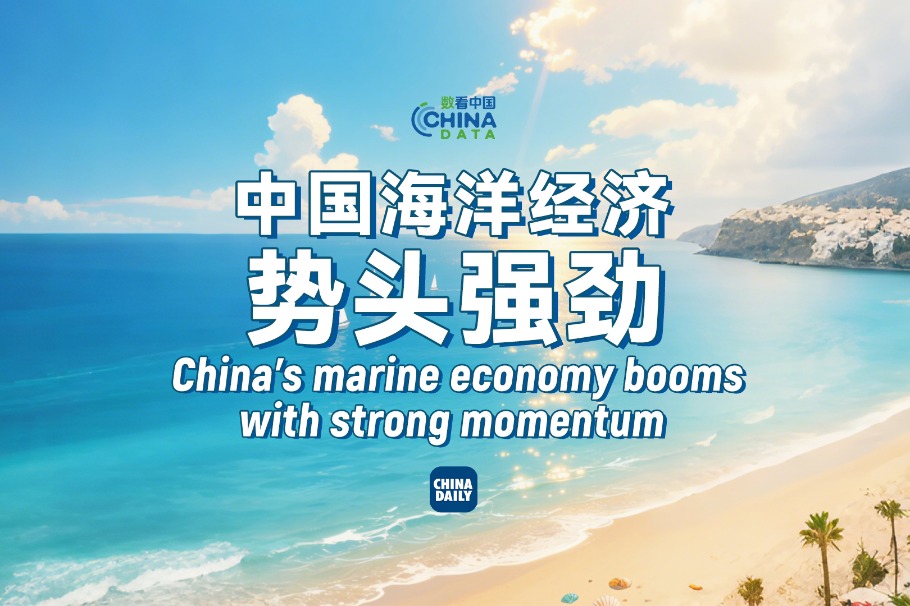Policy can drive 2024 economic transformation


The global economic landscape is projected to witness low growth, moderate inflation and high US interest rates this year.
This is set to accelerate the restructuring of global industrial chains.
In response to external uncertainties, China should be better prepared by expediting economic transformation and elevating the role of consumption in driving growth.
A long-term vision involves a gradual shift from commodity exports to capital output, increasing the scale and efficiency of the country's foreign investments to elevate the gross national product and gross domestic product, which will lead to an enhanced perception of economic growth among the people.
External demand
Witnessing significant changes in export structures, external demand faced pressure in 2023.
Against a pronounced transition in the old and new drivers within the foreign trade sector, China should attach more importance to three key aspects this year.
In terms of global economic and financial trends, the world is expected to witness an impending shift from higher interest rates this year.
Projections from financial institutions across the world suggest that the US Federal Reserve might initiate interest rate cuts in the latter half of 2024 — ranging between 80 and 120 basis points.
The primary triggers for rate reductions are economic deceleration and controlled inflation, potentially resulting in weaker external demand from the United States and Europe.
In addition, ongoing geopolitical tensions and major-power competitions will continue to steer structural adjustments in China's foreign trade.
Following the Russia-Ukraine conflict, China's major export destinations are shifting away from the US and Europe toward the Association of Southeast Asian Nations member states and other emerging economies.
Partners involved in the Belt and Road Initiative and the Regional Comprehensive Economic Partnership are also witnessing increased prominence in China's export landscape.
Advancements in global green and low-carbon transformation have also posed challenges to export performance.
Considering China's current export structure, the imminent introduction of carbon tariffs by the European Union may increase tariff burdens on China's exports to Europe.
Consequently, this year will see certain external pressures on China's foreign trade, where more policy measures to alleviate those will be quickly needed.
Infrastructure investment
Investment in infrastructure plays a pivotal role in driving China's economic recovery.
As the current fiscal policy has shown effectiveness in stimulating and expanding overall social investment, fiscal policy will continue to be a vital force in propelling high single-digit growth in infrastructure investment this year, further bolstering the nation's economic recovery.
During that process, structural challenges in real estate investment cannot be overlooked. Real estate investment constitutes a significant part of fixed-asset investment, and challenges arising from the bubble in the real estate sector call for urgent resolution.
Currently, policies supporting urban-village renovation and the construction of affordable housing have been introduced to mitigate risks. These will help drive investments in the real estate sector to a certain degree.
What's more, the effect of industrial chain relocation on investments and foreign capital flows into China also merits attention.
Since the beginning of the US-China trade conflicts in 2018, the global industrial chain has witnessed fragmentation and relocation, which was also accelerated to some extent by the COVID-19 pandemic.
Developed economies, including the US and Europe, also encourage reinvestment within their borders and diversification of industrial chains. As a result, this year, these factors will remain challenges for China in drawing in foreign investments, which will influence global industrial chain adjustments.
The ongoing shifts in the global industrial chain, accelerated by the US-China trade conflicts and the pandemic, continue to affect China's investments and foreign capital utilization.
Multinational corporations are restructuring supply chains globally, and China's response should involve not only strategic considerations to attract and optimize foreign investments, but also increasing investments in overseas markets, especially those involved in the BRI.
Consumption factor
Compared to investment and net exports, consumption's contribution to China's GDP growth has become increasingly pronounced.
In the first three quarters of 2023, GDP grew 5.2 percent year-on-year, with final consumption expenditure accounting for a significant contribution rate of 94.8 percent in the third quarter.
Policy dividends such as income growth and tax reductions have expanded the space for consumption upgrade, providing a favorable environment for the rise of emerging consumer groups.
The rapid rise of emerging consumer groups and accelerated pace of new urbanization are also accumulating strength in the consumer market. Sustained efforts to increase resident incomes and nurture consumption capabilities remain crucial to expanding domestic demand.
Macro policy
The annual tone-setting Central Economic Work Conference, which was held in December, emphasized the need to intensify fiscal policies for increased efficacy, calling for the maintenance of strong fiscal expenditure while optimizing the combination of deficits, special bonds and interest subsidies.
The meeting called for efforts to pursue progress while ensuring stability, consolidate stability through progress and establish the new before abolishing the old.
Driving economic growth through fiscal policies usually requires a consideration of various factors.
Before 2014, the narrow fiscal deficit ratio and the broad fiscal deficit ratio remained essentially consistent.
However, the gap between the two indicators has widened since 2015. The broad deficit ratio almost doubled that of the other in 2020.
Although the gap has since narrowed, there is potential for a significant increase in the broad deficit ratio this year. Therefore, alongside monitoring the narrow deficit ratio, attention must be paid to the constraints posed by the broad deficit ratio, which may to some extent limit the space for fiscal policies to drive economic growth.
In terms of monetary policy, it is anticipated that there is still ample room for reducing the reserve requirement ratio this year, enabling the release of more liquidity to support economic growth.
However, it is crucial to note that interest rate adjustments must consider the issue of the inverted China-US interest rate spread.
Although China's nominal interest rates are currently lower than those of the US, its real interest rate level, adjusted for inflation, is higher than that of the US.
The inverted spread has exerted significant pressure on the renminbi's exchange rate.
If the Fed reduces interest rates by 80 to 100 basis points in the second half this year, there may be a larger policy space for nominal interest rate adjustments.
Therefore, coherence and logical consistency between different macro policies are crucial to enhancing policy effectiveness.
To avoid conflicting policies, policymakers should push forward coordination and mutual cooperation while introducing policies, and bring new dynamics to the Chinese economy.
It is also essential to pay close attention to market responses to these policies.
The writer is chief economist at Bank of China (Hong Kong).The article is a translation of the writer's speech at a monthly seminar of the China Macroeconomy Forum, a think tank in Beijing.
The views do not necessarily reflect those of China Daily.




































